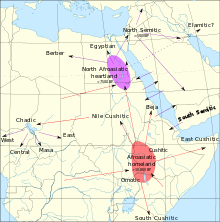Proto-Afroasiatic language

Proto–Afroasiatic is the reconstructed proto-language from which all modern Afroasiatic languages are descended. It is believed by scholars to have been spoken as a single language around 12,000 to 18,000 years ago, although there is no consensus as to where the Afroasiatic Urheimat, the homeland of Proto-Afroasiatic speakers, was located. Although Afroasiatic is the earliest attested language family in the world, the reconstruction of Proto-Afroasiatic is problematic and largely lacking, a fact sometimes attributed to the sheer age of the language. Modern studies suggest based on reconstructed fauna and flora, and seemingly linguistic contact with language families known to have been spoken in Eurasia to put it in the Middle east, probably the Levant. The evidence of Cushitic too once have been spoken in the south of Arabia also speaks for a Middle eastern origin, though some proposals also claim North Africa and the Horn of Africa.[1][2]
Consonant correspondences
The following table shows consonant correspondences in Afroasiatic languages, along with some reconstructed consonants for Proto-Afroasiatic.
| Proto-Afroasiatic | Proto-Semitic | Egyptian | Berber | East Cushitic | West Chadic |
|---|---|---|---|---|---|
| *b | *b | b | *β, ? *b, *-∅- | *b | *b, *ḅ1 |
| *p | *p | p | *f, ? *b | *p | *p, *f, *ḅ1 |
| *f | f | f | |||
| *d | *d | d | *d | *d | *d, *ḍ1 |
| *t | *t | t | *t | *t | *t |
| *ṭ | *ṭ | d(~t) | *ḍ [dˁ] / *ṭ (→ *ṭṭ [tˁː]) | *ṭ (→ *ḍ) | *ḍ |
| *ð | ?? d | *z | *z | *dʒ | |
| *θ | s, ?? š | *s | *s1(=*s) | ||
| *θ̣ | ḏ- | *ẓ [zˁ] | South Cushitic *ṭṣ |
||
| *z | z | *z | *z | *dz | |
| *s | *s | s | *s- ? | s2- | *ts |
| *ṣ [(t)sʼ] | ḏ | *ẓ [zˤ] | *ṭṣ | *ṭṣ | |
| *š (*s2) | s | *s | *s2(=*š) | s, Central Chadic: *s, *ɬ | |
| *ś (*s3) [ɬ] | š, ? s | *s, *z- | *ɬ, SCush. *ɬ |
*ɬ, *ɮ | |
| *ṣ́ (*ṣ3) [(t)ɬʼ] | ḏ, ? d- | *s1 ?, SCush. *ṭɬ̣ |
-*ṭɬ̣- | ||
| *g | g, ḏ | *g | *g | *g | |
| *k | k, ṯ | *k, ? *ṣ | *k | *k | |
| *ḳ | q, ḏ | *ṣ, ? *ḳ (→ *ḳḳ [kˤː]) | |||
| *ṣ | χ-, ʕ- ? | *h2 | *ʕ | ||
| *χ | χ, ẖ, ħ | *H- | *h-, *-Ø- | *-H-? | |
| *ʕ | ʕ | *H- | *ʕ-, *-Ø-ʔ | ||
| *ħ | ħ | *H- | *ħ-, *-Øː- | ||
| *h | ı͗- | *h1, *h2 | *ʔ- | ||
| *ʔ | ı͗, ? ꜣ | *ʔ | *ʔ, -Ø- | *ʔ | |
| *r | ꜣ, r | *r | -*r- | *r | |
| *ɬ | n-, [l-], r, ꜣ | *ɬ | -*ɬ- | *ɬ | |
| *w | w-, ı͗, y | *w, *Ø | *w, *Ø | *w-? | |
| *y | ı͗-, y-, -Ø- | *y, *i, *Ø | *y, *i, *Ø | *y, *Ø | |
| Proto-Afroasiatic | Proto-Semitic | Egyptian | Berber | East Cushitic | West Chadic |
- under special conditions
NOTE:
- š = /ʃ/
- Symbols with dots underneath are emphatic consonants (variously glottalized, ejective or pharyngealized).
- Transcription of Ancient Egyptian follows Allen (2000); see Transliteration of Ancient Egyptian. The following are possible values for the non-IPA symbols used for Ancient Egyptian: ẖ = [ç]; ṯ = [tʲ] or [t͡ʃ]; ḏ = [dʲ] or [d͡ʒ], or ejective [tʲʼ] or [t͡ʃʼ].
Pronouns
Ehret (1995) reconstructs the following pronouns, most of which are supported by at least five of the six branches:
| Singular, bound | Singular, independent | Plural | |
|---|---|---|---|
| 1 | *i, *yi | *(ʔ)ân-/(ʔ)în- | *(ʔ)ǎnn-/(ʔ)ǐnn- |
| 2 m. | *ku, *ka | *(ʔ)ânt/(ʔ)înt- | *kuuna |
| 2 f. | *ki | ||
| 3 | *si, *isi | *su, *usu | |
Numerals
Ehret (1995) reconstructs the following cardinal numbers (Ehret does not include Berber in his reconstruction):
| Number | Proto-Afroasiatic | Proto-Semitic | Egyptian | Proto-Cushitic | Proto-Chadic | Proto-Omotic |
|---|---|---|---|---|---|---|
| two | *tsan, *can | *θny | snwj | |||
| *tsîr(n), *cîr(n) | *θər | *sər | ||||
| *ɬâm- | *ɬmʔl "left hand" | *ɬâ(a)m- | *lam- | |||
| three | *xaynz- | *knɗ- | *x2ayz- | |||
| four | *fâzw- | fdw | *fʷaɗə |
The first root for "two" has been compared to Berber (Tamazight) sin.[6] There are other proposed cognate sets:
- "six": Egyptian srs, Proto-Semitic *šidṯ-, Berber (Tamazight) sdˁis.[6]
- "seven": Egyptian sfḫ, Proto-Semitic *šabʕ-, Berber (Tamazight) sa.[6]
See also
Notes
- ↑ Blench, Roger. (2006). Archaeology, Language, and the African Past. Rowman: Altamira,. ISBN 9780759104662.
- ↑ Blažek, Václav. "Afro-Asiatic linguistic migrations: linguistic evidence." (PDF).
- ↑ Dolgopolsky (1999), pp. 38-39.
- ↑ Prasse (2000), p. 346.
- 1 2 Ehret (1995)
- 1 2 3 Takács, Gábor (1999-). Etymological Dictionary of Egyptian. Brill. Check date values in:
|date=(help)
References
- Dolgopolsky, Aron (1999). From Proto-Semitic to Hebrew. Milan: Centro Studi Camito-Semitici di Milano.
- Ehret, Christopher (1995). Reconstructing Proto-Afroasiatic (Proto-Afrasian): vowels, tone, consonants, and vocabulary. University of California Press. ISBN 0-520-09799-8.
- Prasse, Karl G. (2000). Études berbères et chamito-sémitiques: mélanges offerts à Karl-G. Prasse.